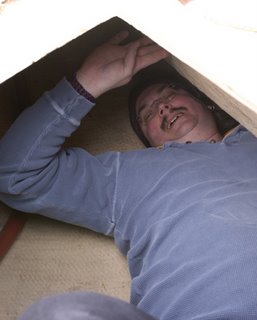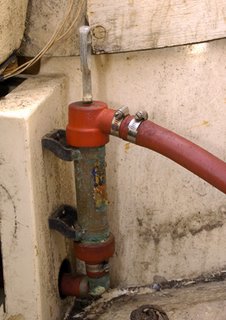Sailing with Retta, and more lessons learned

Retta and I took the 'Duck out for a sail today. We left late morning and played around out in the estuary off the marina. The wind was clipping along at 15 kts, from the West Northwest, so we reached down the channel at between 5 and 7.2 knots.
When we reached Sandy Point, though, Retta noticed all the other sailboats were a) heading in, and b) under strongly reefed jib or reefed mains'l alone. There was a reason for this. We decided to head back to the Marina, because we had things to do (ha). We had no trouble jibing our way out, but when we came about and headed to weather, we were heeling over more than I wanted, and we were having trouble controlling the boat. We were flying a #3 genoa and a main that doesn't have any reef points. We realized we were seriously overcanvassed.
I went forward (lesson here - should have put on a life jacket since I was working the foredeck with an inexperienced helmsman) and dropped the genoa, with some difficulty. I bungeed it down on the foredeck in case we needed it again, rather than just stuffing it back in the bag.
We were then in the channel, between the Aberdeen Proving Ground and Turkey Point, under main alone. A Catalina 340 and a Bene (looked like about a 36 footer) were both having difficulties. The Bene furled her sails and started to motor. The Catalina, under a deeply reefed fores'l and a reefed main, attempted to come about but failed. Attempted again and failed. a third time and made it. We tried to come about as well, but there was too little power for the windage. We fell off, built up speed again, and tried again. No dice. By this time, we were out of the channel and approaching shallow water.
I decided to use the engine to help us come about. On the third pull, my elbow hit the organizer I had hung on the rail, and knocked the handheld VHF into the drink. I hope King Neptune is having fun with my radio. Loretta is joking that I should find one with a float.
After we got the engine running, we realized we were still overcanvassed, so we dropped the main. We were able to make over 3 knots under power, even into the wind, so Retta found a jacket and a blanket, took a nap in the cockpit, and I took us back up the channel to the marina.

All in all, it was a great day! Yes, out of inexperience we stressed the rig and carried too much sail, but we got them down ok and powered back. Yes, we lost a VHF, but a) it wasn't my cell phone, and b) Retta and I had a FANTASTIC time sailing off the wind.
When we got back to Tidewater, we did a passable job of tying up. Then we ran up to the store to get cap leashes (we both felt like our caps were going to blow off). Then we squared away the boat and went to Price's for a plate full of crabs. Yes, all in all, it was a beautiful day of sailing. Now off to Defender to find another VHF. Oh, we also noticed the foreward hatch has finally cracked all the way. I'm not sure if I should replace it with a production hatch (about 500 bucks) or just get a new sheet of Lexan to replace the broken plexi (about 200 bucks). I'm leaning towards the size 60 Lewmar low profile. But that's for later....













